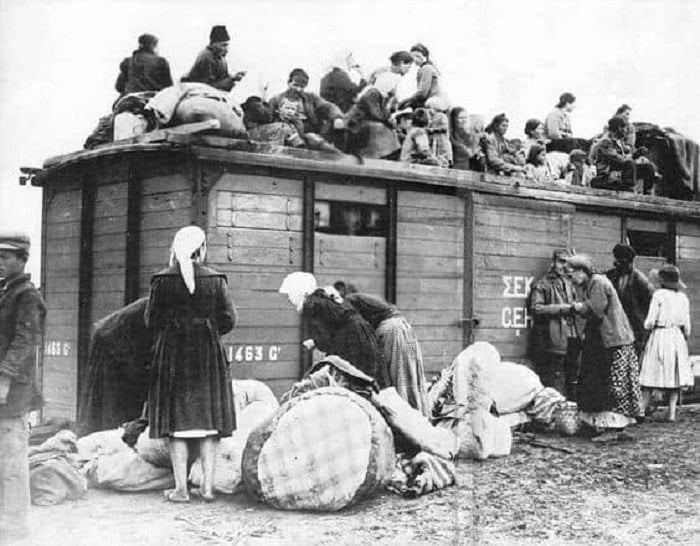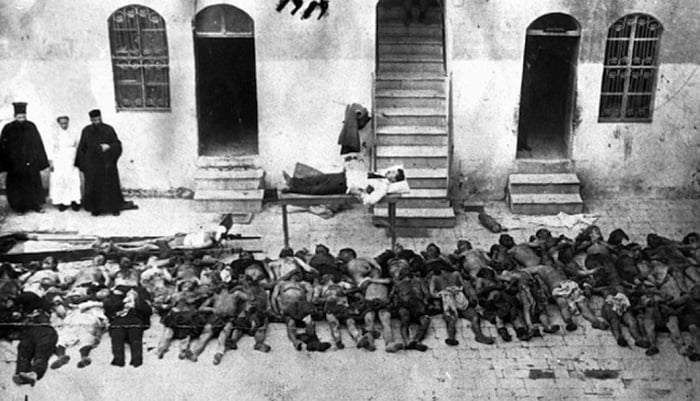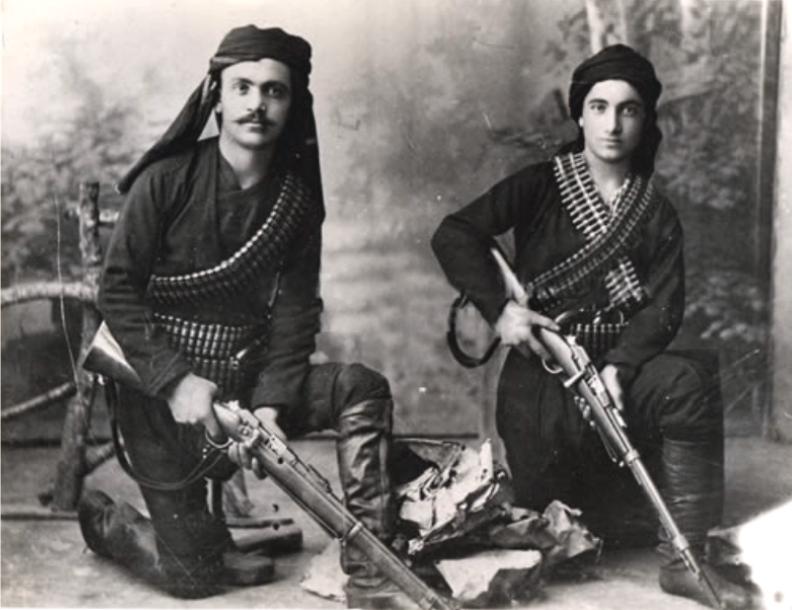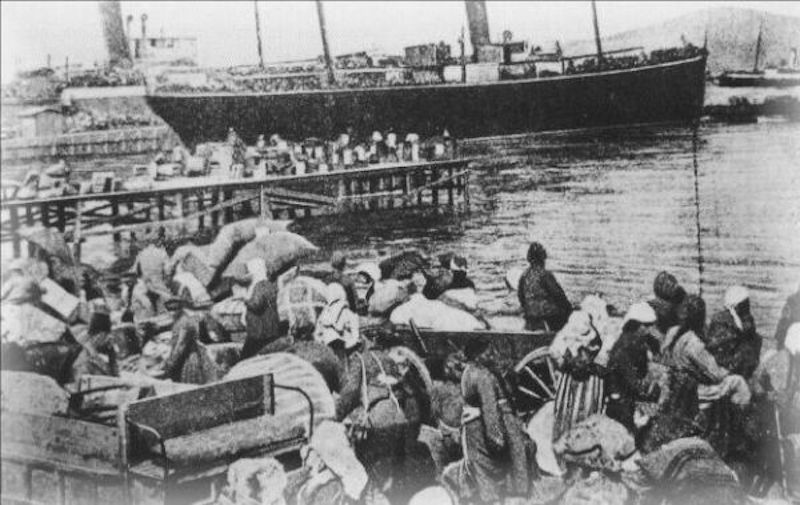
Greece marks May 19th as Pontic Genocide Remembrance Day, to honor the memory of approximately 353,000 Pontian Greeks exterminated by the New Turks and the Ottoman Empire between 1916 and 1923.
In one of the darkest chapters in Greece’s long history, the Pontic Genocide included an organized plan to eliminate the indigenous Greek population Anatolia. It included massacres, forced deportations involving death marches, expulsions, executions, and the wholesale destruction of Eastern Orthodox cultural, historical, and religious monuments.
The Turks feared that the Greek-speaking Christian population would welcome liberation from the Ottoman Empire’s enemies.
At the same time, the nationalist Turks believed in the creation of a modern nation without strong, influential ethnic and religious minorities; this was one of the main factors that led to the Greek genocide.
At the outbreak of World War I, there were many minorities that had been living in Asia Minor long before the creation of the Ottoman Empire, including Greeks, Pontic Greeks, Caucasus Greeks, Cappadocian Greeks, Armenians, Kurds, Assyrians, and Jews among others.
The Ottoman Empire was in rapid decline, headed by the Committee of Union and Progress (“CUP”). The CUP were, among other things, proponents of Turkish nationalism.
When the Ottomans joined the Central Powers of Germany and Austria-Hungary in 1914, the stage was set for the first genocide of the twentieth century.
Using Christian rebels colluding with the Russian Army as a pretext, the Ottoman government announced a policy of property confiscation and deportations against the Christian minorities of the empire—first amongst them being the Armenians.
The Armenian genocide
The extermination of the Armenian population in 1915 was the first atrocity that paved the way for the Greek genocide with it culmination in 1923 following the Burning of Smyrna.
Most historians believe the final decision to proceed with extermination of the Armenian population was reached at the end of March or early April of 1915.
Turkish Minister of War Enver Pasha took over command of the Ottoman armies for the invasion of Russian territory and attempted to encircle the Russian Caucasus Army at the Battle of Sarikamish, which took place from December 1914 to January 1915.
The Turkish Army suffered a humiliating defeat, losing more than 60,000 men. However, while retreating, the Turks destroyed dozens of Armenian villages in Bitlis Vilayet, massacring their inhabitants.
Upon his return to Constantinople, in an attempt to deflect blame for his failures, Enver Pasha publicly blamed his defeat on Armenians in the region, accusing them of siding with the Russians.
The atrocities began with the arrest of Armenian intellectuals in Constantinople and the aim to eliminate Armenian leadership, as well as anyone capable of organizing resistance.
Those arrested were tortured and eventually murdered after being forced to confess to a nonexistent Armenian conspiracy against the empire. The persecution continued with a centralized agenda of deportations, murder, pillage and rape until 1923.
Ordinary Armenians were driven from their homes and sent on death marches through the Mesopotamian desert without food or water. Armenian sources estimate the number of deaths to be a staggering 600,000 to 1.5 million.
Ottoman death squads continually massacred Armenians until there were only 388,000 left in the empire by 1923. This, from a population of two million in 1914. Turkey, however, estimates the total number of deaths to be 300,000.
Apart from downplaying the number of victims, Turkish governments have—to this day— continued to deny the Armenian genocide, calling it just another part of the First World War.
The genocide of Armenian people committed by Turkey was finally officially recognized by U.S. President Joe Biden on April 24, 2021 in an official declaration.
The Turkish government reacted vehemently against the U.S. President’s decision.

The Pontic genocide
The history of Pontic Greeks goes as far back as Ancient Greece itself. The first recorded Greek colony, established on the northern shores of ancient Anatolia, was Sinope on the Black Sea (Pontus), circa 800 BC.
The settlers of Sinope were merchants from the Ionian Greek city state of Miletus. At the time, the shores of the Black Sea were known to the Greek world as the “Inhospitable Sea” (in Greek, “Axeinos Pontos”) with the name later changing to “Hospitable Sea” (Euxeinos Pontos” in Greek).
After the fall of the Black Sea kingdom of Trebizond (centered around modern-day Trabzon) to the Ottomans in 1461 and especially during the 18th and 19th century wars, Pontians migrated to southern Russia and the Caucasus.
By the mid-19th century, the Greeks of Pontus were flourishing, economically and demographically. In 1865, there were 265,000 Pontians, but by 1880 their number had grown to 330,000.
By the early 20th century, their population had reached 700,000, and in 1860, there were 100 Greek schools in Pontus along with printing businesses, newspapers, magazines, clubs, and theaters.
The year 1908 was a grim milestone for the peoples of the Ottoman Empire. It was the year of the formation of the “Young Turk” movement, the extremist nationalist party that launched the persecution of Christian communities to ensure the Turkification of the region.
These Turks, on the pretext of “national security,” displaced the majority of the Greek population in Asia Minor’s inhospitable hinterland via so-called “labor battalions.”
The men who would not join the Turkish Army were forced to join these units. They were put to work in quarries, mines and road construction under crippling, inhumane conditions. Most soon died of hunger and disease.
Reacting to the oppression of the Turks—the murders, deportations, and burning of villages —the Pontic Greeks took to the mountains to salvage what was left of their lives.
After the genocide of the Armenians, the Turkish nationalists under Mustafa Kemal Ataturk then began the Pontic genocide.
In 1919, the Greeks and Armenians, along with the temporary support of the Eleftherios Venizelos government of Greece, attempted to create a standalone Greek-Armenian state.
This plan was thwarted by the Turks, who took advantage of the event to advance to their “final solution,” the Pontic genocide.
On May 19, 1919, Ataturk landed in Samsun to start the second and most brutal phase of the Pontic Greek genocide under the guidance of German and Soviet advisers.
By the time of the Asia Minor catastrophe of 1922, the number of Pontians who died had exceeded 200,000; some historians put the figure at 350,000.
Those who escaped the Turkish sword fled as refugees to southern Russia. After the end of the 1919 to 1922 Greco-Turkish War, most of the Pontian Greeks remaining in the Ottoman Empire were transported to Greece under the terms of the 1923 population exchange.
The number of people exchanged between Greece and Turkey is estimated to have been at 400,000.

After the Pontic genocide
In 1996, Turkish researcher Ömer Asan made headlines with his book the “Culture of Pontus” (Pontos Kültürü) in which he suggested that up to 300,000 people still speak Pontic Greek.
Asan, originally from the region of Of, in Trabzon, an area with a strong Islamic tradition and a substantial Greek-speaking population, was charged with violating Turkey’s “Anti-Terrorism Law” by “propagandizing separatism” before he was acquitted in 2003.
In a 2000 interview with the Greek edition of the International Herald Tribune, the author maintained that “there are still people in Turkey today who speak and understand Pontian, which is the oldest surviving Greek dialect.”
“The members of this community come from Trabzon and are scattered throughout Turkey, or have emigrated to other countries. Pontian is spoken in sixty villages in the Trabzon region, most of them in the Of area,” Assan maintained.
“At a conservative estimate, I would say this dialect is spoken by around 300,000 people,” he concluded.
Pontic Greek is an endangered Indo-European language spoken by about 778,000 people worldwide. However, only 200,000 to 300,000 individuals are considered active speakers of the tongue.
The language is mainly spoken in northern Greece but is also spoken in Russia, Armenia, Georgia, and Kazakhstan, as well as by members of the Pontic diaspora worldwide.
Greeks in Asia Minor
Greeks had inhabited Asia Minor at least since the Late Bronze Age (1450 BC). The poet Homer, who wrote the Iliad and Odyssey, lived in the region at around 800 BC.
The geographer Strabo referred to Smyrna as the first Greek city in Asia Minor with many historical Greek figures recorded as hailing from the area.
The mathematician Thales of Miletus (7th century), philosopher Heraclitus of Ephesus (6th century BC), and the founder of Cynicism Diogenes of Sinope (4th century BC) were among them.
The Hellenization of the region accelerated under Roman and early Byzantine rule with the Koine Greek language dominating until the late Middle Ages.
Almost all indigenous inhabitants of Asia Minor practiced Greek Orthodox Christianity after the East–West Schism with the Catholics in 1054 and spoke Greek as their first language.
When the Turkic peoples began their late medieval conquest of Asia Minor, Byzantine Greek citizens were the largest group of inhabitants already present in the area.
After the Turkic conquests and the fall of Constantinople, the Greek natives of Asia Minor gradually became a minority over the following four centuries under the Turkish culture which had by then become dominant in the region.
Census before the burning of Smyrna
Smyrna was a multicultural and cosmopolitan center until September 1922. Opposing sources claim that Greeks and Turks constituted the majority in the city, according to their point of view.
According to Katherine Elizabeth Flemming, in 1919 to 1922, the Greeks in Smyrna numbered 150,000, forming just under half of the population and outnumbering the Turks by a ratio of two to one.
The city also had sizeable Armenian, Jewish, and Levantine communities. According to Trudy Ring, before World War I, Greeks alone numbered 130,000 out of a population of 250,000, excluding Armenians and other Christians.
According to the Ottoman census of 1905, there were 100,356 Muslims, 73,636 Orthodox Christians, 11,127 Armenian Christians, and 25,854 individuals of various other backgrounds; the updated figures for 1914 show 111,486 Muslims compared to 87,497 Orthodox Christians.
The American Consul General in Smyrna at the time, George Horton, wrote that before the fire, there had been 400,000 people living in the city of Smyrna of whom 165,000 were Turks and 150,000 were Greeks.
In addition, there were 25,000 Jews, 25,000 Armenians, and 20,000 foreigners, comprised of 10,000 Italians, 3,000 French, 2,000 British, and 300 Americans. Most of the Greeks and Armenians were Christians.
Moreover, according to scholars, prior to the war, Smyrna had more Greeks living in the city than there were Greeks residing in Athens, the capital of Greece.
The Ottomans of that era referred to the city as Infidel Smyrna (Gavur Izmir) due to the numerous Greeks and large non-Muslim population.

The Greco-Turkish War
In November 1914, Turkish troops destroyed Christian properties and murdered several Christians at Trabzon (Trebizond).
However, Germany intervened and asked the Turks to stop the violence against Greeks. This was after Greek Prime Minister Eleftherios Venizelos had promised Greece’s neutrality to the German ambassador in Athens.
Venizelos had also threatened to undertake a similar campaign against Muslims who were living in Greece.
Arbitrary violence and killings of Greeks by the Turks continued, nevertheless. According to George W. Rendel of the British Foreign Office, by 1918 “over 500,000 Greeks were deported—of whom comparatively few survived.”
The United States ambassador to the Ottoman Empire between 1913 and 1916 wrote: “Everywhere the Greeks were gathered in groups and, under the so-called protection of Turkish gendarmes, they were transported, the larger part on foot, into the interior.”
“Just how many were scattered in this fashion is not definitely known, the estimates varying anywhere from 200,000 up to 1,000,000,” the report said.
A 1919 Patriarchate account recorded the evacuation of many villages, with looting and murders taking place, while many died as they were relocated to uninhabitable places.
The Ottomans capitulated on October 30, 1918 at the end of World War I. In the Turkish Courts-Martial of 1919 to 1920, a number of leading Ottoman officials were accused of ordering massacres against both Greeks and Armenians.
However, the killings and deportations continued, unofficially, leading to the inevitable Greco-Turkish War, which raged from May 1919 to October 1922.
Greece’s armed forces arrived in Smyrna on May 15, 1919 under cover of the Greek, French, and British Navies.
Atrocities on both sides took place in the war that stopped only to start up once again. After major military and political errors made by the Greek government, the Turkish army regained control of the city on September 9, 1922.
The future for the Christian population of Greeks and Armenians in the city was in peril. Following a series of catastrophic events, the majority would be wiped off the face of the earth as part of the Greek genocide.
The Burning of Smyrna and Greek Genocide
The re-taking of Smyrna by Turkish troops meant the end of the city as it had been known up to that time.
Eyewitness reports state that the great fire of Smyrna began on September 13, 1922 and lasted for approximately nine full days until September 22nd. The results were catastrophic, as the entire Greek and Armenian quarters of the city were completely wiped off the map.
Churches, ornate villas, and mansions of great architectural importance, as well as schools and entire market areas, were gone forever—without a trace.
The entire city and the harbor were ablaze. Thousands of homeless, panic-stricken people surged back and forth on the quay.
The shrieks of women and children, along with the blaze, formed an infernal wail. People were seen throwing themselves into the water, and only some would reach a ship and safety.
The mass of frenzied people would not allow any boat to approach the harbor. The atmosphere was absolutely stifling. Many drowned, and some were crushed by the howling, desperate mob.
Official data about the number of victims of the Smyrna fires and the 1922 Greek genocide are nonexistent. Experts believe that the number of Greek genocide victims is between 10,000 and 100,000.
The number of refugees who were forced to leave the city and its surrounding countryside was between 25,000 and 100,000.
The city suffered such enormous damage to its infrastructure that much of it literally had to be rebuilt from ashes.
Greek neighborhoods, where some of the most beautiful homes, churches, and buildings were located, and the entire forty hectares of what was once the most elegant part of the city, had become a hellish inferno with no building left standing but razed to the ground.

The Greek genocide
The cataclysmic fire of Smyrna was the culmination of the Greek genocide. It was an extermination plan that had gone on, mostly unhindered, for a decade.
British Prime Minister Lloyd George stated before the House of Commons that “tens of thousands of [Greek] men, women and children were expelled and dying [in the Ottoman Empire]. It was clearly a deliberate extermination.”
Hundreds of thousands of Greeks were killed between 1914 and 1923. They were not soldiers but ordinary civilians whose ancestors had lived in the Ottoman Empire for hundreds of years—and had lived in Asia Minor since time immemorial.
The American ambassador at the time, Henry Morgenthau, wrote to the United States after becoming alarmed at the extermination campaigns launched by the Turks. There are numerous first-hand memoirs, such as that of Grigoris Balakian, that recount the horrors of those years.
However, ever since those horrendous years, Turkey has described the Christian deaths as merely the casualties of war. The world knew very well that a Greek genocide had happened, but there were no consequences.
Unlike after World War II, there was no Nuremburg or other war tribunals. There was no compensation for the victims’ families, and life in the wider world simply continued as if nothing had happened.
There was one world leader who remembered very well what had happened, however. Adolf Hitler, who was soon to seize power in Germany, uttered the phrase “Who remembers the Armenians?” when he plotted how he would carry out another genocide—this time on European soil.
Whether Armenian or Greek, no one came to the aid of these ancient peoples when they became the victims of one of the greatest atrocities in the world.
See all the latest news from Greece and the world at Greekreporter.com. Contact our newsroom to report an update or send your story, photos and videos. Follow GR on Google News and subscribe here to our daily email!



